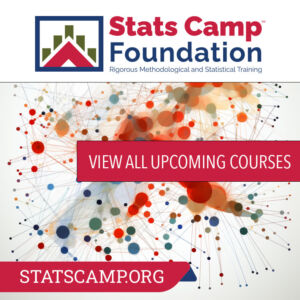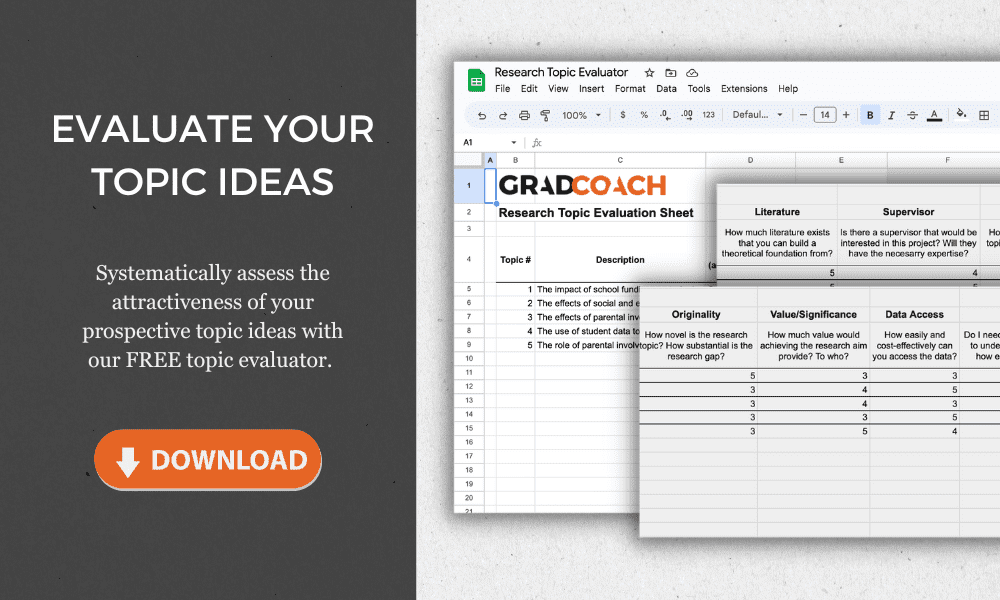Statistical Research Questions: Five Examples for Quantitative Analysis
Table of contents, introduction.
How are statistical research questions for quantitative analysis written? This article provides five examples of statistical research questions that will allow statistical analysis to take place.
In quantitative research projects, writing statistical research questions requires a good understanding and the ability to discern the type of data that you will analyze. This knowledge is elemental in framing research questions that shall guide you in identifying the appropriate statistical test to use in your research.
Thus, before writing your statistical research questions and reading the examples in this article, read first the article that enumerates the four types of measurement scales . Knowing the four types of measurement scales will enable you to appreciate the formulation or structuring of research questions.
Once you feel confident that you can correctly identify the nature of your data, the following examples of statistical research questions will strengthen your understanding. Asking these questions can help you unravel unexpected outcomes or discoveries particularly while doing exploratory data analysis .

Five Examples of Statistical Research Questions
In writing the statistical research questions, I provide a topic that shows the variables of the study, the study description, and a link to the original scientific article to give you a glimpse of the real-world examples.
Topic 1: Physical Fitness and Academic Achievement
A study was conducted to determine the relationship between physical fitness and academic achievement. The subjects of the study include school children in urban schools.
Statistical Research Question No. 1
Is there a significant relationship between physical fitness and academic achievement?
Notice that this study correlated two variables, namely 1) physical fitness, and 2) academic achievement.
To allow statistical analysis to take place, there is a need to define what is physical fitness, as well as academic achievement. The researchers measured physical fitness in terms of the number of physical fitness tests that the students passed during their physical education class. It’s simply counting the ‘number of PE tests passed.’
On the other hand, the researchers measured academic achievement in terms of a passing score in Mathematics and English. The variable is the number of passing scores in both Mathematics and English.
Both variables are ratio variables.
Given the statistical research question, the appropriate statistical test can be applied to determine the relationship. A Pearson correlation coefficient test will test the significance and degree of the relationship. But the more sophisticated higher level statistical test can be applied if there is a need to correlate with other variables.
In the particular study mentioned, the researchers used multivariate logistic regression analyses to assess the probability of passing the tests, controlling for students’ weight status, ethnicity, gender, grade, and socioeconomic status. For the novice researcher, this requires further study of multivariate (or many variables) statistical tests. You may study it on your own.
Most of what I discuss in the statistics articles I wrote came from self-study. It’s easier to understand concepts now as there are a lot of resource materials available online. Videos and ebooks from places like Youtube, Veoh, The Internet Archives, among others, provide free educational materials. Online education will be the norm of the future. I describe this situation in my post about Education 4.0 .
The following video sheds light on the frequently used statistical tests and their selection. It is an excellent resource for beginners. Just maintain an open mind to get rid of your dislike for numbers; that is, if you are one of those who have a hard time understanding mathematical concepts. My ebook on statistical tests and their selection provides many examples.
Source: Chomitz et al. (2009)
Topic 2: Climate Conditions and Consumption of Bottled Water
This study attempted to correlate climate conditions with the decision of people in Ecuador to consume bottled water, including the volume consumed. Specifically, the researchers investigated if the increase in average ambient temperature affects the consumption of bottled water.
Statistical Research Question No. 2
Is there a significant relationship between average temperature and amount of bottled water consumed?
In this instance, the variables measured include the average temperature in the areas studied and the volume of water consumed . Temperature is an interval variable, while volume is a ratio variable .
In this example, the variables include the average temperature and volume of bottled water . The first variable (average temperature) is an interval variable, and the latter (volume of water) is a ratio variable.
Now, it’s easy to identify the statistical test to analyze the relationship between the two variables. You may refer to my previous post titled Parametric Statistics: Four Widely Used Parametric Tests and When to Use Them . Using the figure supplied in that article, the appropriate test to use is, again, Pearson’s Correlation Coefficient.
Source: Zapata (2021)
Topic 3: Nursing Home Staff Size and Number of COVID-19 Cases

An investigation sought to determine if the size of nursing home staff and the number of COVID-19 cases are correlated. Specifically, they looked into the number of unique employees working daily, and the outcomes include weekly counts of confirmed COVID-19 cases among residents and staff and weekly COVID-19 deaths among residents.
Statistical Research Question No. 3
Is there a significant relationship between the number of unique employees working in skilled nursing homes and the following:
- number of weekly confirmed COVID-19 cases among residents and staff, and
- number of weekly COVID-19 deaths among residents.
Note that this study on COVID-19 looked into three variables, namely 1) number of unique employees working in skilled nursing homes, 2) number of weekly confirmed cases among residents and staff, and 3) number of weekly COVID-19 deaths among residents.
We call the variable number of unique employees the independent variable , and the other two variables ( number of weekly confirmed cases among residents and staff and number of weekly COVID-19 deaths among residents ) as the dependent variables .
This correlation study determined if the number of staff members in nursing homes influences the number of COVID-19 cases and deaths. It aims to understand if staffing has got to do with the transmission of the deadly coronavirus. Thus, the study’s outcome could inform policy on staffing in nursing homes during the pandemic.
A simple Pearson test may be used to correlate one variable with another variable. But the study used multiple variables. Hence, they produced regression models that show how multiple variables affect the outcome. Some of the variables in the study may be redundant, meaning, those variables may represent the same attribute of a population. Stepwise multiple regression models take care of those redundancies. Using this statistical test requires further study and experience.
Source: McGarry et al. (2021)
Topic 4: Surrounding Greenness, Stress, and Memory
Scientific evidence has shown that surrounding greenness has multiple health-related benefits. Health benefits include better cognitive functioning or better intellectual activity such as thinking, reasoning, or remembering things. These findings, however, are not well understood. A study, therefore, analyzed the relationship between surrounding greenness and memory performance, with stress as a mediating variable.
Statistical Research Question No. 4
Is there a significant relationship between exposure to and use of natural environments, stress, and memory performance?
As this article is behind a paywall and we cannot see the full article, we can content ourselves with the knowledge that three major variables were explored in this study. These are 1) exposure to and use of natural environments, 2) stress, and 3) memory performance.
Referring to the abstract of this study, exposure to and use of natural environments as a variable of the study may be measured in terms of the days spent by the respondent in green surroundings. That will be a ratio variable as we can count it and has an absolute zero point. Stress levels can be measured using standardized instruments like the Perceived Stress Scale . The third variable, i.e., memory performance in terms of short-term, working memory, and overall memory may be measured using a variety of memory assessment tools as described by Murray (2016) .
As you become more familiar and well-versed in identifying the variables you would like to investigate in your study, reading studies like this requires reading the method or methodology section. This section will tell you how the researchers measured the variables of their study. Knowing how those variables are quantified can help you design your research and formulate the appropriate statistical research questions.
Source: Lega et al. (2021)
Topic 5: Income and Happiness
This recent finding is an interesting read and is available online. Just click on the link I provide as the source below. The study sought to determine if income plays a role in people’s happiness across three age groups: young (18-30 years), middle (31-64 years), and old (65 or older). The literature review suggests that income has a positive effect on an individual’s sense of happiness. That’s because more money increases opportunities to fulfill dreams and buy more goods and services.
Reading the abstract, we can readily identify one of the variables used in the study, i.e., money. It’s easy to count that. But for happiness, that is a largely subjective matter. Happiness varies between individuals. So how did the researcher measured happiness? As previously mentioned, we need to see the methodology portion to find out why.
If you click on the link to the full text of the paper on pages 10 and 11, you will read that the researcher measured happiness using a 10-point scale. The scale was categorized into three namely, 1) unhappy, 2) happy, and 3) very happy.
An investigation was conducted to determine if the size of nursing home staff and the number of COVID-19 cases are correlated. Specifically, they looked into the number of unique employees working daily, and the outcomes include weekly counts of confirmed COVID-19 cases among residents and staff and weekly COVID-19 deaths among residents.
Statistical Research Question No. 5
Is there a significant relationship between income and happiness?
Source: Måseide (2021)
Now the statistical test used by the researcher is, honestly, beyond me. I may be able to understand it how to use it but doing so requires further study. Although I have initially did some readings on logit models, ordered logit model and generalized ordered logit model are way beyond my self-study in statistics.
Anyhow, those variables found with asterisk (***, **, and **) on page 24 tell us that there are significant relationships between income and happiness. You just have to look at the probability values and refer to the bottom of the table for the level of significance of those relationships.
I do hope that upon reaching this part of the article, you are now well familiar on how to write statistical research questions. Practice makes perfect.
References:
Chomitz, V. R., Slining, M. M., McGowan, R. J., Mitchell, S. E., Dawson, G. F., & Hacker, K. A. (2009). Is there a relationship between physical fitness and academic achievement? Positive results from public school children in the northeastern United States. Journal of School Health , 79 (1), 30-37.
Lega, C., Gidlow, C., Jones, M., Ellis, N., & Hurst, G. (2021). The relationship between surrounding greenness, stress and memory. Urban Forestry & Urban Greening , 59 , 126974.
Måseide, H. (2021). Income and Happiness: Does the relationship vary with age?
McGarry, B. E., Gandhi, A. D., Grabowski, D. C., & Barnett, M. L. (2021). Larger Nursing Home Staff Size Linked To Higher Number Of COVID-19 Cases In 2020: Study examines the relationship between staff size and COVID-19 cases in nursing homes and skilled nursing facilities. Health Affairs, 40(8), 1261-1269.
Zapata, O. (2021). The relationship between climate conditions and consumption of bottled water: A potential link between climate change and plastic pollution. Ecological Economics, 187, 107090.
© P. A. Regoniel 12 October 2021 | Updated 08 January 2024
Related Posts

Good Research Problem: Four Critical Elements

Chi-Square Test Example Computation and Practical Application
The role of statistics in decision making, about the author, patrick regoniel.
Dr. Regoniel served as consultant to various environmental research and development projects covering issues and concerns on climate change, coral reef resources and management, economic valuation of environmental and natural resources, mining, and waste management and pollution. He has extensive experience on applied statistics, systems modelling and analysis, an avid practitioner of LaTeX, and a multidisciplinary web developer. He leverages pioneering AI-powered content creation tools to produce unique and comprehensive articles in this website.
Quantitative Research: Examples of Research Questions and Solutions
Are you ready to embark on a journey into the world of quantitative research? Whether you’re a seasoned researcher or just beginning your academic journey, understanding how to formulate effective research questions is essential for conducting meaningful studies. In this blog post, we’ll explore examples of quantitative research questions across various disciplines and discuss how StatsCamp.org courses can provide the tools and support you need to overcome any challenges you may encounter along the way.
Understanding Quantitative Research Questions
Quantitative research involves collecting and analyzing numerical data to answer research questions and test hypotheses. These questions typically seek to understand the relationships between variables, predict outcomes, or compare groups. Let’s explore some examples of quantitative research questions across different fields:

- What is the relationship between class size and student academic performance?
- Does the use of technology in the classroom improve learning outcomes?
- How does parental involvement affect student achievement?
- What is the effect of a new drug treatment on reducing blood pressure?
- Is there a correlation between physical activity levels and the risk of cardiovascular disease?
- How does socioeconomic status influence access to healthcare services?
- What factors influence consumer purchasing behavior?
- Is there a relationship between advertising expenditure and sales revenue?
- How do demographic variables affect brand loyalty?
Stats Camp: Your Solution to Mastering Quantitative Research Methodologies
At StatsCamp.org, we understand that navigating the complexities of quantitative research can be daunting. That’s why we offer a range of courses designed to equip you with the knowledge and skills you need to excel in your research endeavors. Whether you’re interested in learning about regression analysis, experimental design, or structural equation modeling, our experienced instructors are here to guide you every step of the way.
Bringing Your Own Data
One of the unique features of StatsCamp.org is the opportunity to bring your own data to the learning process. Our instructors provide personalized guidance and support to help you analyze your data effectively and overcome any roadblocks you may encounter. Whether you’re struggling with data cleaning, model specification, or interpretation of results, our team is here to help you succeed.
Courses Offered at StatsCamp.org
- Latent Profile Analysis Course : Learn how to identify subgroups, or profiles, within a heterogeneous population based on patterns of responses to multiple observed variables.
- Bayesian Statistics Course : A comprehensive introduction to Bayesian data analysis, a powerful statistical approach for inference and decision-making. Through a series of engaging lectures and hands-on exercises, participants will learn how to apply Bayesian methods to a wide range of research questions and data types.
- Structural Equation Modeling (SEM) Course : Dive into advanced statistical techniques for modeling complex relationships among variables.
- Multilevel Modeling Course : A in-depth exploration of this advanced statistical technique, designed to analyze data with nested structures or hierarchies. Whether you’re studying individuals within groups, schools within districts, or any other nested data structure, multilevel modeling provides the tools to account for the dependencies inherent in such data.
As you embark on your journey into quantitative research, remember that StatsCamp.org is here to support you every step of the way. Whether you’re formulating research questions, analyzing data, or interpreting results, our courses provide the knowledge and expertise you need to succeed. Join us today and unlock the power of quantitative research!
Follow Us On Social! Facebook | Instagram | X

933 San Mateo Blvd NE #500, Albuquerque, NM 87108
4414 82 nd Street #212-121 Lubbock, TX 79424
Monday – Friday: 9:00 AM – 5:00 PM
© Copyright 2003 - 2024 | All Rights Reserved Stats Camp Foundation 501(c)(3) Non-Profit Organization.

Statistics Resources
- Excel - Tutorials
- Basic Probability Rules
- Single Event Probability
- Complement Rule
- Intersections & Unions
- Compound Events
- Levels of Measurement
- Independent and Dependent Variables
- Entering Data
- Central Tendency
- Data and Tests
- Displaying Data
- Discussing Statistics In-text
- SEM and Confidence Intervals
- Two-Way Frequency Tables
- Empirical Rule
- Finding Probability
- Accessing SPSS
- Chart and Graphs
- Frequency Table and Distribution
- Descriptive Statistics
- Converting Raw Scores to Z-Scores
- Converting Z-scores to t-scores
- Split File/Split Output
- Sampling Methods
- Partial Eta Squared
- Downloading and Installing G*Power: Windows/PC
- Correlation
- Testing Parametric Assumptions
- One-Way ANOVA
- Two-Way ANOVA
- Repeated Measures ANOVA
- Goodness-of-Fit
- Test of Association
- Pearson's r
- Point Biserial
- Mediation and Moderation
- Simple Linear Regression
- Multiple Linear Regression
- Binomial Logistic Regression
- Multinomial Logistic Regression
- Independent Samples T-test
- Dependent Samples T-test
- Testing Assumptions
- T-tests using SPSS
- T-Test Practice
Quantitative Research Questions
- Null & Alternative Hypotheses
- One-Tail vs. Two-Tail
- Alpha & Beta
- Associated Probability
- Decision Rule
- Statement of Conclusion
- Statistics Group Sessions
ASC Chat Hours
ASC Chat is usually available at the following times ( Pacific Time):
If there is not a coach on duty, submit your question via one of the below methods:
928-440-1325
Ask a Coach
Search our FAQs on the Academic Success Center's Ask a Coach page.
Research Questions Tutorial

What is a Quantitative Research Question?

A research question is the driving question(s) behind your research. It should be about an issue that you are genuinely curious and/or passionate about. A good research question is:
Clear : The purpose of the study should be clear to the reader, without additional explanation.
Focused : The question is specific. Narrow enough in scope that it can be thoroughly explored within the page limits of the research paper. It brings the common thread that weaves throughout the paper.
Concise : Clarity should be obtained in the fewest possible words. This is not the place to add unnecessary descriptors and fluff (i.e. “very”).
Complex : A true research question is not a yes/no question. It brings together a collection of ideas obtained from extensive research, without losing focus or clarity.
Arguable : It doesn’t provide a definitive answer. Rather, it presents a potential position that future studies could debate.
The format of a research question will depend on a number of factors, including the area of discipline, the proposed research design, and the anticipated analysis.
Unclear: Does loneliness cause the jitters? Clear: What is the relationship between feelings of loneliness, as measured by the Lonely Inventory, and uncontrollable shaking?
Unfocused: What’s the best way to learn? Focused: In what ways do different teaching styles affect recall and retention in middle schoolers?
Verbose : Can reading different books of varying genres influence a person’s performance on a test that measures familiarity and knowledge of different words?
Concise: How does exposure to words through reading novels influence a person’s language development?
Definitive: What is my favorite color? Arguable: What is the most popular color amongst teens in America?
Developing a Quantitative Research Question
Developing a research question, was this resource helpful.
- << Previous: T-Test Practice
- Next: Hypothesis Testing >>
- Last Updated: Oct 31, 2024 9:47 AM
- URL: https://resources.nu.edu/statsresources

- Examples of good research questions
Last updated
Reviewed by
Tanya Williams
However, developing a good research question is often challenging. But, doing appropriate data analysis or drawing meaningful conclusions from your investigation with a well-defined question make it easier.
So, to get you on the right track, let’s start by defining a research question, what types of research questions are common, and the steps to drafting an excellent research question.
Make research less tedious
Dovetail streamlines research to help you uncover and share actionable insights
- What is a research question?
The definition of a research question might seem fairly obvious.
At its simplest, a research question is a question you research to find the answer.
Researchers typically start with a problem or an issue and seek to understand why it has occurred, how it can be solved, or other aspects of its nature.
As you'll see, researchers typically start with a broad question that becomes narrower and more specific as the research stages are completed.
In some cases, a study may tackle more than one research question.
- Research question types
Research questions are typically divided into three broad categories: qualitative, quantitative, and mixed-method.
These categories reflect the research type necessary to answer the research question.
Qualitative research
When you conduct qualitative research, you're broadly exploring a subject to analyze its inherent qualities.
There are many types of qualitative research questions, which include:
Descriptive: describing and illuminating little-known or overlooked aspects of a subject
Emancipatory: uncovering data that can serve to emancipate a particular group of people, such as disadvantaged or marginalized communities
Evaluative: assessing how well a particular research approach or method works
Explanatory: answering “how” or “why” a given phenomenon occurs
Exploratory: identifying reasons behind certain behaviors and exploring motivations (also known as generative research because it can generate solutions to problems)
Ideological: researching ideologies or beliefs, such as political affiliation
Interpretive: understanding group perceptions, decision-making, and behavior in a natural setting
Predictive: forecasting a likely outcome or scenario by examining past events
While it's helpful to understand the differences between these qualitative research question types, writing a good question doesn't start with determining the precise type of research question you'll be asking.
It starts with determining what answers you're seeking.
Quantitative research
Unlike broad, flexible qualitative research questions, quantitative research questions are precise. They also directly link the research question and the proposed methodology.
So, in a quantitative research question, you'll usually find
The study method
An independent variable (or variables)
A dependent variable
The study population
Quantitative research questions can also fall into multiple categories, including:
Comparative research questions compare two or more groups according to specific criteria and analyze their similarities and differences.
Descriptive questions measure a population's response to one or more variables.
Relationship (or relationship-based) questions examine how two or more variables interact.

Mixed-methods research
As its name suggests, mixed-methods research questions involve qualitative and quantitative components.
These questions are ideal when the answers require an evaluation of a specific aspect of a phenomenon that you can quantify and a broader understanding of aspects that can't.
- How to write a research question
Writing a good research question can be challenging, even if you're passionate about the subject matter.
A good research question aims to solve a problem that still needs to be answered and can be solved empirically.
The approach might involve quantitative or qualitative methodology, or a mixture of both. To write a well-developed research question, follow the four steps below:
1. Select a general topic
Start with a broad topic. You may already have one in mind or get one assigned to you. If you don't, think about one you're curious about.
You can also use common brainstorming techniques , draw on discussions you've had with family and friends, take topics from the news, or use other similar sources of inspiration.
Also, consider a subject that has yet to be studied or addressed. If you're looking to tackle a topic that has already been thoroughly studied, you'll want to examine it from a new angle.
Still, the closer your question, approach, and outcomes are to existing literature, the less value your work will offer. It will also be less publishing-worthy (if that’s your goal).
2. Conduct preliminary research
Next, you'll want to conduct some initial research about your topic. You'll read coverage about your topic in academic journals, the news, and other credible sources at this stage.
You'll familiarize yourself with the terminology commonly used to describe your topic and the current take from subject matter experts and the general public.
This preliminary review helps you in a few ways. First, you'll find many researchers will discuss challenges they found conducting their research in their "Limitations," "Results," and "Discussion" sections of research papers.
Assessing these sections also helps you avoid choosing the wrong methodological approach to answering your question. Initial research also enables you to avoid focusing on a topic that has already been covered.
You can generate valuable research questions by tracking topics that have yet to be covered.
3. Consider your audience
Next, you'll want to give some thought to your audience. For example, what kinds of research material are they looking for, and what might they find valuable?
Reflect on why you’re conducting the research.
What is your team looking to learn if your research is for a work assignment?
How does what they’re asking for from you connect to business goals?
Understanding what your audience is seeking can help you shape the direction of your research so that the final draft connects with your audience.
If you're writing for an academic journal, what types of research do they publish? What kinds of research approaches have they published? And what criteria do they expect submitted manuscripts to meet?
4. Generate potential questions
Take the insights you've gained from your preliminary research and your audience assessment to narrow your topic into a research question.
Your question should be one that you can answer using the appropriate research methods. Unfortunately, some researchers start with questions they need more resources to answer and then produce studies whose outcomes are limited, limiting the study's value to the broader community.
Make sure your question is one you can realistically answer.
- Examples of poor research questions
"How do electronics distract teen drivers?"
This question could be better from a researcher's perspective because it is overly broad. For instance, what is “electronics” in this context? Some electronics, like eye-monitoring systems in semi-autonomous vehicles, are designed to keep drivers focused on the road.
Also, how does the question define “teens”? Some states allow you to get a learner's permit as young as 14, while others require you to be 18 to drive. Therefore, conducting a study without further defining the participants' ages is not scientifically sound.
Here's another example of an ineffective research question:
"Why is the sky blue?"
This question has been researched thoroughly and answered.
A simple online search will turn up hundreds, if not thousands, of pages of resources devoted to this very topic.
Suppose you spend time conducting original research on a long-answered question; your research won’t be interesting, relevant, or valuable to your audience.
Alternatively, here's an example of a good research question:
"How does using a vehicle’s infotainment touch screen by drivers aged 16 to 18 in the U.S. affect driving habits?"
This question is far more specific than the first bad example. It notes the population of the study, as well as the independent and dependent variables.
And if you're still interested in the sky's color, a better example of a research question might be:
"What color is the sky on Proxima Centauri b, based on existing observations?"
A qualitative research study based on this question could extrapolate what visitors on Proxima Centauri b (a planet in the closest solar system to ours) might see as they look at the sky.
You could approach this by contextualizing our understanding of how the light scatters off the molecules of air resulting in a blue sky, and the likely composition of Proxima Centauri b's atmosphere from data NASA and others have gathered.
- Why the right research question is critical
As you can see from the examples, starting with a poorly-framed research question can make your study difficult or impossible to complete.
Or it can lead you to duplicate research findings.
Ultimately, developing the right research question sets you up for success. It helps you define a realistic scope for your study, informs the best approach to answer the central question, and conveys its value to your audience.
That's why you must take the time to get your research question right before you embark on any other part of your project.
Should you be using a customer insights hub?
Do you want to discover previous research faster?
Do you share your research findings with others?
Do you analyze research data?
Start for free today, add your research, and get to key insights faster
Editor’s picks
Last updated: 5 September 2023
Last updated: 19 January 2023
Last updated: 11 September 2023
Last updated: 21 September 2023
Last updated: 21 June 2023
Last updated: 16 December 2023
Last updated: 30 September 2024
Last updated: 11 January 2024
Last updated: 14 February 2024
Last updated: 27 January 2024
Last updated: 17 January 2024
Last updated: 13 May 2024
Latest articles
Related topics, a whole new way to understand your customer is here, log in or sign up.
Get started for free
- 4.9 - Estimation and Prediction Research Questions
In the remainder of this lesson, we are concerned with answering two different types of research questions. Our goal here — and throughout the practice of statistics — is to translate the research questions into reasonable statistical procedures.
Let's take a look at examples of these two types of research questions:
1. What is the mean weight, \(\mu\), of all American women, aged 18-24?
If we wanted to estimate \(\mu\), what would be a good estimate? It seems reasonable to calculate a confidence interval for \(\mu\) using \(\bar{y}\), the average weight of a random sample of American women, aged 18-24.
2. What is the weight, y , of an individual American woman, aged 18-24?
If we want to predict y , what would be a good prediction? It seems reasonable to calculate a "prediction interval" for y using, again, \(\bar{y}\), the average weight of a random sample of American women, aged 18-24.
A person's weight is, of course, highly associated with the person's height. In answering each of the above questions, we likely could do better by taking into account a person's height. That's where an estimated regression equation becomes useful.
Here are some weight and height data from a sample of n = 10 people, ( student_height_weight.txt ):

If we used the average weight of the 10 people in the sample to estimate \(\mu\), we would claim that the average weight of all American women aged 18-24 is 158.8 pounds regardless of the height of the women. Similarly, if we used the average weight of the 10 people in the sample to predict y , we would claim that the weight of an individual American women aged 18-24 is 158.8 pounds regardless of the woman's height.
On the other hand, if we used the estimated regression equation to estimate \(\mu\), we would claim that the average weight of all American women aged 18-24 who are only 64 inches tall is -266.5 + 6.1(64) = 123.9 pounds. [This calculation is based on rounded estimated regression coefficients; if you use unrounded estimates you'll get an answer closer to 126.4.] Similarly, we would predict that the weight y of an individual American women aged 18-24 who is only 64 inches tall is 123.9 pounds. This example makes it clear that we get significantly different (and better!) answers to our research questions when we take into account a person's height.
Let's make it clear that it is one thing to estimate \(\mu_Y\) and yet another thing to predict y . (Note that we subscript \(\mu\) with Y to make it clear that we are talking about the mean of the response Y not the mean of the predictor x .)
Let's return to our example in which we consider the potential relationship between the predictor "high school gpa" and the response "college entrance test score."

For this example, we could ask two different research questions concerning the response:
- What is the mean college entrance test score for the subpopulation of students whose high school gpa is 3? (Answering this question entails estimating the mean response \(\mu_Y\) when x = 3.)
- What college entrance test score can we predict for a student whose high school gpa is 3? (Answering this question entails predicting the response \(y_{new}\) when x = 3.)
The two research questions can be asked more generally as:
- What is the mean response \(\mu_Y\) when the predictor value is \(x_{h}\) ?
- What value will a new response \(y_{new}\) be when the predictor value is \(x_{h}\)?
Let's take a look at one more example, namely, the one concerning the relationship between the response "skin cancer mortality" and the predictor "latitude" ( skincancer.txt ). Again, we could ask two different research questions concerning the response:
- What is the expected (mean) mortality rate due to skin cancer for all locations at 40 degrees north latitude?
- What is the predicted mortality rate for an individual location at 40 degrees north, say at Chambersburg, Pennsylvania?
At some level, answering these two research questions is straightforward. Both just involve using the estimated regression equation:

That is, \(\hat{y}_h=b_0+b_1x_h\) is the best answer to each research question. It is the best guess of the mean response at \(x_{h}\), and it is the best guess of a new response at x h :
- Our best estimate of the mean mortality rate due to skin cancer for all locations at 40 degrees north latitude is 389.19 - 5.97764(40) = 150 deaths per 10 million people.
- Our best prediction of the mortality rate due to skin cancer in Chambersburg, Pennsylvania is 389.19 - 5.97764(40) = 150 deaths per 10 million people.
The problem with the answers to our two research questions is that we'd have obtained a completely different answer if we had selected a different random sample of data. As always, to be confident in the answer to our research questions, we should put an interval around our best guesses. We learn how to do this in the next two sections. That is, we first learn a " confidence interval for \(\mu_{Y}\)" and then a " prediction interval for \(y_{new}\)."
Start Here!
- Welcome to STAT 462!
- Search Course Materials
- Lesson 1: Statistical Inference Foundations
- Lesson 2: Simple Linear Regression (SLR) Model
- Lesson 3: SLR Evaluation
- 4.1 - Residuals
- 4.2 - Residuals vs. Fits Plot
- 4.3 - Residuals vs. Predictor Plot
- 4.4 - Identifying Specific Problems Using Residual Plots
- 4.5 - Residuals vs. Order Plot
- 4.6 - Normal Probability Plot of Residuals
- 4.7 - Assessing Linearity by Visual Inspection
- 4.8 - Further Residual Plot Examples
- 4.10 - Confidence Interval for the Mean Response
- 4.11 - Prediction Interval for a New Response
- 4.12 - Further Example of Confidence and Prediction Intervals
- Lesson 5: Multiple Linear Regression (MLR) Model & Evaluation
- Lesson 6: MLR Assumptions, Estimation & Prediction
- Lesson 7: Transformations & Interactions
- Lesson 8: Categorical Predictors
- Lesson 9: Influential Points
- Lesson 10: Regression Pitfalls
- Lesson 11: Model Building
- Lesson 12: Logistic, Poisson & Nonlinear Regression
- Website for Applied Regression Modeling, 2nd edition
- Notation Used in this Course
- R Software Help
- Minitab Software Help

Copyright © 2018 The Pennsylvania State University Privacy and Legal Statements Contact the Department of Statistics Online Programs

🚀 Work With Us
Private Coaching
Language Editing
Qualitative Coding
✨ Free Resources
Templates & Tools
Short Courses
Articles & Videos
Research Question Examples 🧑🏻🏫

Research Question Examples
- Psychology research questions
- Business research questions
- Education research questions
- Healthcare research questions
- Computer science research questions
Examples: Psychology
Let’s start by looking at some examples of research questions that you might encounter within the discipline of psychology.
How does sleep quality affect academic performance in university students?
This question is specific to a population (university students) and looks at a direct relationship between sleep and academic performance, both of which are quantifiable and measurable variables.
What factors contribute to the onset of anxiety disorders in adolescents?
The question narrows down the age group and focuses on identifying multiple contributing factors. There are various ways in which it could be approached from a methodological standpoint, including both qualitatively and quantitatively.
Do mindfulness techniques improve emotional well-being?
This is a focused research question aiming to evaluate the effectiveness of a specific intervention.
How does early childhood trauma impact adult relationships?
This research question targets a clear cause-and-effect relationship over a long timescale, making it focused but comprehensive.
Is there a correlation between screen time and depression in teenagers?
This research question focuses on an in-demand current issue and a specific demographic, allowing for a focused investigation. The key variables are clearly stated within the question and can be measured and analysed (i.e., high feasibility).

Examples: Business/Management
Next, let’s look at some examples of well-articulated research questions within the business and management realm.
How do leadership styles impact employee retention?
This is an example of a strong research question because it directly looks at the effect of one variable (leadership styles) on another (employee retention), allowing from a strongly aligned methodological approach.
What role does corporate social responsibility play in consumer choice?
Current and precise, this research question can reveal how social concerns are influencing buying behaviour by way of a qualitative exploration.
Does remote work increase or decrease productivity in tech companies?
Focused on a particular industry and a hot topic, this research question could yield timely, actionable insights that would have high practical value in the real world.
How do economic downturns affect small businesses in the homebuilding industry?
Vital for policy-making, this highly specific research question aims to uncover the challenges faced by small businesses within a certain industry.
Which employee benefits have the greatest impact on job satisfaction?
By being straightforward and specific, answering this research question could provide tangible insights to employers.
Examples: Education
Next, let’s look at some potential research questions within the education, training and development domain.
How does class size affect students’ academic performance in primary schools?
This example research question targets two clearly defined variables, which can be measured and analysed relatively easily.
Do online courses result in better retention of material than traditional courses?
Timely, specific and focused, answering this research question can help inform educational policy and personal choices about learning formats.
What impact do US public school lunches have on student health?
Targeting a specific, well-defined context, the research could lead to direct changes in public health policies.
To what degree does parental involvement improve academic outcomes in secondary education in the Midwest?
This research question focuses on a specific context (secondary education in the Midwest) and has clearly defined constructs.
What are the negative effects of standardised tests on student learning within Oklahoma primary schools?
This research question has a clear focus (negative outcomes) and is narrowed into a very specific context.
Need a helping hand?
Examples: Healthcare
Shifting to a different field, let’s look at some examples of research questions within the healthcare space.
What are the most effective treatments for chronic back pain amongst UK senior males?
Specific and solution-oriented, this research question focuses on clear variables and a well-defined context (senior males within the UK).
How do different healthcare policies affect patient satisfaction in public hospitals in South Africa?
This question is has clearly defined variables and is narrowly focused in terms of context.
Which factors contribute to obesity rates in urban areas within California?
This question is focused yet broad, aiming to reveal several contributing factors for targeted interventions.
Does telemedicine provide the same perceived quality of care as in-person visits for diabetes patients?
Ideal for a qualitative study, this research question explores a single construct (perceived quality of care) within a well-defined sample (diabetes patients).
Which lifestyle factors have the greatest affect on the risk of heart disease?
This research question aims to uncover modifiable factors, offering preventive health recommendations.

Examples: Computer Science
Last but certainly not least, let’s look at a few examples of research questions within the computer science world.
What are the perceived risks of cloud-based storage systems?
Highly relevant in our digital age, this research question would align well with a qualitative interview approach to better understand what users feel the key risks of cloud storage are.
Which factors affect the energy efficiency of data centres in Ohio?
With a clear focus, this research question lays a firm foundation for a quantitative study.
How do TikTok algorithms impact user behaviour amongst new graduates?
While this research question is more open-ended, it could form the basis for a qualitative investigation.
What are the perceived risk and benefits of open-source software software within the web design industry?
Practical and straightforward, the results could guide both developers and end-users in their choices.
Remember, these are just examples…
In this post, we’ve tried to provide a wide range of research question examples to help you get a feel for what research questions look like in practice. That said, it’s important to remember that these are just examples and don’t necessarily equate to good research topics . If you’re still trying to find a topic, check out our topic megalist for inspiration.

You Might Also Like:

How To Choose A Tutor For Your Dissertation
Hiring the right tutor for your dissertation or thesis can make the difference between passing and failing. Here’s what you need to consider.

5 Signs You Need A Dissertation Helper
Discover the 5 signs that suggest you need a dissertation helper to get unstuck, finish your degree and get your life back.

Writing A Dissertation While Working: A How-To Guide
Struggling to balance your dissertation with a full-time job and family? Learn practical strategies to achieve success.

How To Review & Understand Academic Literature Quickly
Learn how to fast-track your literature review by reading with intention and clarity. Dr E and Amy Murdock explain how.

Dissertation Writing Services: Far Worse Than You Think
Thinking about using a dissertation or thesis writing service? You might want to reconsider that move. Here’s what you need to know.
📄 FREE TEMPLATES
Research Topic Ideation
Proposal Writing
Literature Review
Methodology & Analysis
Academic Writing
Referencing & Citing
Apps, Tools & Tricks
The Grad Coach Podcast
Research ideas on Political Science
Submit a Comment Cancel reply
Your email address will not be published. Required fields are marked *
Save my name, email, and website in this browser for the next time I comment.
Submit Comment
- Print Friendly

IMAGES
VIDEO
COMMENTS
Five Examples of Statistical Research Questions. In writing the statistical research questions, I provide a topic that shows the variables of the study, the study description, and a link to the original scientific article to give you a glimpse of the real-world examples. Topic 1: Physical Fitness and Academic Achievement
Understanding Quantitative Research Questions. Quantitative research involves collecting and analyzing numerical data to answer research questions and test hypotheses. These questions typically seek to understand the relationships between variables, predict outcomes, or compare groups. Let's explore some examples of quantitative research ...
If you want to know more about the research process, methodology, research bias, or statistics, make sure to check out some of our other articles with explanations and examples. Methodology. Sampling methods; ... 10 Research Question Examples to Guide your Research Project. Scribbr. Retrieved December 13, 2024, from https://www.scribbr.com ...
A research question is the driving question(s) behind your research. It should be about an issue that you are genuinely curious and/or passionate about. A good research question is: Clear: The purpose of the study should be clear to the reader, without additional explanation. Focused: The question is specific. Narrow enough in scope that it can ...
In this lesson, we are concerned with answering two different types of research questions. Our goal here — and throughout the practice of statistics — is to translate the research questions into reasonable statistical procedures. Let's take a look at examples of the two types of research questions we learn how to answer in this lesson: 1.
Each sample has the same mean, 10.00. In order to answer (b) and (c) below, refer to the empirical rule for interpreting s, taking into account the shape of the histogram. Do not try to calculate s because you do not have enough information to do so. In addition, you will receive no credit for
Quantitative research questions can also fall into multiple categories, including: Comparative research questions compare two or more groups according to specific criteria and analyze their similarities and differences. Descriptive questions measure a population's response to one or more variables.
Some examples of different types of research questions are presented below: Discover How We Assist to Edit Your Dissertation Chapters. Aligning theoretical framework, gathering articles, synthesizing gaps, articulating a clear methodology and data plan, and writing about the theoretical and practical implications of your research are part of ...
In the remainder of this lesson, we are concerned with answering two different types of research questions. Our goal here — and throughout the practice of statistics — is to translate the research questions into reasonable statistical procedures. Let's take a look at examples of these two types of research questions: 1.
A well-crafted research question (or set of questions) sets the stage for a robust study and meaningful insights. But, if you're new to research, it's not always clear what exactly constitutes a good research question. In this post, we'll provide you with clear examples of quality research questions across various disciplines, so that you can approach your research project with confidence!